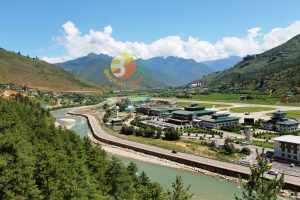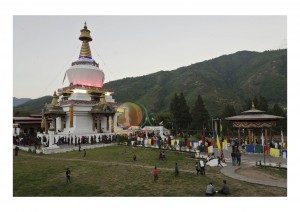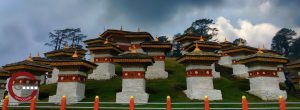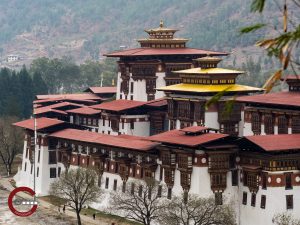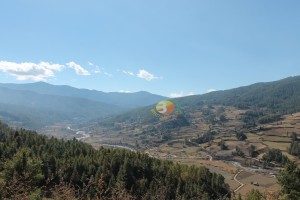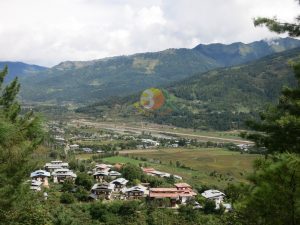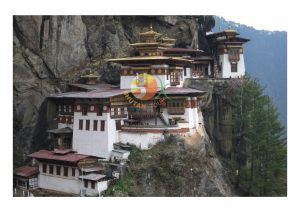The Dochula Druk Wangyel Festival Was Established In 2011 In Commemoration Of His Majesty The Fourth Druk Gyalpo And The Armed Forces’ Victory Over Indian Insurgent Forces Residing In Southern Bhutan In 2003.
Druk Wangyel Festival is an annual festival held on December 13th at the Druk Wangyal Lhakhang Festival Ground located at Dochula Pass around 22km from the capital city Thimphu. Dochula Pass is one of the most scenic locations in the entire kingdom, offering a stunning panoramic view of the Himalayan mountain range. Set amidst this breathtaking backdrop, the Dochula Druk Wangyal Tsehchu is an experience unlike any other and truly exemplifies Bhutanese cultural traditions.
The Druk Wangyal Lhakhang was built over a period of four years (2004-2008) under the vision and patronage of Her Majesty the Queen Mother Ashi Dorji Wangmo. The Lhakhang honors the courageous service of the Fourth King, who personally led the troops against the insurgents, as well as the regular Armed Forces of the country
Day 01: Drive Paro to Thimphu, 55 Km 2 hours’ drive (L / D)
Day 02: Thimphu (B / L / D)
Day 03: Thimphu / Punakha. 74 KM, around 3 hours’ drive. (B / L / D)
Day 04: Punakha (B / L / D)
Day 05: Punakha to Gangtey / Phobjikha, 70 KM, 4 hours’ drive. (B / L / D)
Day 06: Gangtey / Phobjikha / Gogona. (B / L / D)
Day 07: Gogona to Trongsa (B / L / D)
Day 08: Trongsa – Tang Valley (B / L / D)
Day 09: Tang- Bumthang (B / L / D)
Day 10: Bumthang – Thimphu (B / L / D)
Day 11: Thimphu – Paro (B / L / D)
Day 12: Paro (B / L / D)
Day 13: Depart from PARO (B)
(12 Nights 13 Days)
Paro- Thimphu – Punakha – Phobjikha – Gogona- Bumthang
Day 01: Drive Paro to Thimphu, 55 Km 2 hours’ drive (L / D)
The flight into Bhutan (from Bangkok /Delhi/ Singapore) takes you over the great Himalayas, offering the scintillating scenery of the world’s highest glacial peaks. As you enter Paro valley, you will see the silvery Pa Chu (Paro River) meandering down the valley, the Paro Dzong (fortress) and Ta Dzong (watch tower). On arrival, received by our representative and transfer to Thimphu (55 km, 1.5 hours) the modern capital town of Bhutan.
Then proceed to Buddha Dordenma is a gigantic Shakyamuni Buddha statue. The statue can house over one hundred thousand smaller Buddha statues, each of which, like the Buddha Dordenma itself, the Buddha Dordenma is sited amidst the ruins of Kuensel Phodrang.
In evening continue to Trashichhodzong; the beautiful fortress/monastery which houses Secretariat building, King’s Throne room, and other government’s offices. It is also the summer residence of Chief Abbot. As well as witness the ceremony of the national flag.
Overnight at the hotel Jumolhari in Thimphu:
Day 02: Thimphu (B / L / D)
Today’s full day of sightseeing in Thimphu valley includes, visit; After Breakfast drive to Memorial Chorten; the beautiful stupa built in the memory of Bhutan’s third King. The paintings and statues inside the monument provide a deep insight into Buddhist philosophy. Painting School; famous for traditional Thangkha paintings, Textile and Folk Heritage Museum; the fascinating testimony of the Bhutanese material culture and living traditions.
After lunch precedes Handicrafts Emporium; it displays the wide assortment of beautifully hand-woven and crafted products and visits vegetable market if open.
Overnight at the hotel Jumolhari in Thimphu:
Day 03: Thimphu / Punakha. 74 KM, around 3 hours’ drive. (B / L / D)
After early breakfast, drive to Dochula pass (3,050m). on the way attend the Druk Wangyel Festival. If the weather permits, you can see a range of high Himalayan peaks towards the northeast. Following peaks can be seen from this pass, on a clear day ; Masagang (7,158m), Tsendagang (6,960m), Terigang (7,060m ), Jejegangphugang (7,158 m ), Kangphugang (7,170 m ), Zongphugang (7, 060 m ), a table mountain that dominates the isolated region of Lunana – finally Gangkar puensum, the highest peak in Bhutan at 7,497m.
The descent from Dochula into Punakha/Wangduephodrang valley follows the winding road as the altitude difference is 1700 meters.
On the way visit Chimi Lhakhang, situated on a hillock in the center of the Lobesa valley, is dedicated to Lama Drukpa Kuenley, who in the late 15th century used humor, songs and outrageous behavior to dramatize his teachings and due to this also known as ‘Divine Madman’. This temple is also known as the temple of fertility. It is widely believed that couples who do not have children and wanting one, if they pray at this temple, they are usually blessed with a child very soon. It is about 30-minute walk across the field from the road to the temple or you can drive directly to temple.
Overnight at the Zhingkham Resort in Punakha:
Day 04: Punakha (B / L / D)
After breakfast drive to Khamsum Yulley Namgyal stands majestically on a strategic ridge above the Punakha valley. Built over a period of 9 years, Bhutanese craftsmen including carpenters, painters, and sculptors consulted Holy Scriptures rather than engineering manuals, to construct this 4-story temple.
It is a splendid example of Bhutan’s fine architectural and artistic traditions and the only one of its kind in the world. Built by Her Majesty the Queen Mother, this temple is dedicated to the wellbeing of the kingdom and the benefit of all sentient beings.
After lunch visits Punakha Dzong, a massive structure built at the junction of two rivers. Punakha was Bhutan’s capital until 1955, and Punakha Dzong still serves as the winter residence of the central monk body. Bhutan’s first King, Ugyen Wangchuck, was crowned here in 1907. The fortress has withstood several damages from fire, earthquake, and flood over the centuries. The latest flood, in October 1994, caused great damages to the fortress but miraculously spared its most holy statue.
Overnight at the Zhingkham Resort in Punakha:
Day 05: Punakha to Gangtey / Phobjikha, 70 KM, 4 hours’ drive. (B / L / D)
After breakfast drive to Gangtey / Phobjikha. In the mountains east of Wangduephodrang lies the beautiful Phobjikha valley, after crossing Tsele La (3440m) the trail crosses several pastures, and then descends through the mixed forest of Juniper, bamboo, magnolia, and rhododendron. Drive to the great monastery of Gangtey, established in the 17th century. The village of Phobjikha lies a few km, down from the monastery, on the valley floor. This quite, remote valley is the winter home of black necked cranes, which migrate from the arid plains of Tibet in the north, to pass the winter months in a milder climate. Explore Gangtey village and Phobjikha valley. Overnight Phojikha Valley in Dewachen Hotel.
Day 06: Gangtey / Phobjikha / Gogona. (B / L / D)
After breakfast drive to the Tselela Pass then it is a gradual descent for some time through the forest of juniper, bamboo, magnolia, and rhododendron. The people of Gogona were originally nomads and they speak a language called Jobkha- (the language of the nomads) visit the dairy farm and temple. Overnight Gogona Valley in Farm House.
Day 07: Gogona to Trongsa (B / L / D)
After Breakfast proceeds to Trongsa Dzong, situated at the alt. of 2,200m and built in 1647 by the Shabdrung, it is the most impressive Dzong in Bhutan. Then visit the Ta Dzong, standing on the side of the mountain and built to guard Trongsa. Overnight at the lodge in Trongsa
Day 08: Trongsa – Tang Valley (B / L / D)
After Breakfast proceeds to Bumthang, one of the most spectacular valleys in Bhutan and also the heartland of Buddhism. 29 km ahead of Trongsa cross Yutongla pass (3,400m) and from here again the landscape looks different and dense forests of conifers stretches. The arrival of Bumthang begins with wide, open cultivated Chumey valley. Overnight at the Ogyen Choling guest house.
Tang is one of the four valleys of Bumthang district and it is higher than Choskhor (Jakar). From Jakar, following the west-east road towards Ura for about 10km, unpaved road on the left (north) branches off climbing up the hill, leading to narrow gorge of Tang. Almost immediately after the turn-off, there is a parking lot for short walk to Membartsho. The road climbs above the river and reaches Drangchel village after 7km. Perched on a high cliff above the road, you will notice the monastic hermitage of Kunzangdrak Goemba, founded in 1488 by Pema Lingpa. This is a side excursion which takes around 2hrs of the steep uphill climb. Continuing along the high feeder road for about 3km, you will pass through Jamzhong village and then after a short descent of 2km or so, you will arrive at Mesethang with a school and few shops. The short distance away from Mesethang is Tang Rimochen Lhakhang, located below an enormous rock. Tang Rimochen Lhakhang marks a sacred place where Guru Rinpoche meditated. A rock in front of the lhakhang has a body-print of the Guru and two consorts. The name Tag Rimoche (an impression of tiger’s stripes) is derived from the tiger stripes that appear on a rock cliff behind the building. The temple was founded in 14 century by Dorji Lingpa. After Rimochen, the road is rougher as it approaches Kizum, 3km away. Beyond Kizum, tractor road continues to Gamling and sheep breeding center. From Kizum, cross the bridge over Tang chu river and climb up to the hilltop Ugyencholing manor. Ugyen Chholing Palace was originally built by Deb Tsokye Dorje, a descendant of Dorje Lingpa in 16century. The present structure, including the temple, servant’s quarters and a massive residential building, was rebuilt after their collapse in the 1897 earthquake. The complex has been turned into a museum of sorts for religious studies, research, and solitude. It exhibits in the main building are captioned with descriptions of the lifestyle and artworks of a Bhutanese noble family.
As a part of the activities to make Ogyen Choling self-sustainable, a guest house was opened under the trust fund. The revenue generated from the guest house goes into the trust fund.
Day 09: Tang- Bumthang (B / L / D)
After Breakfast proceeds to Jakar, Bumthang or Chokhor valley is the cultural heartland of the Kingdom, dotted with many ancient monasteries and UNESCO heritage sites. After lunch, we begin our valley walking tour, visiting 7th-century Jambay Lhakhang, followed by the shortstop at Chakar Lhakhang and then visit Kurjey temple complex. Cross the river over the suspension bridge to Dorjibi village, where you should be able to see a local weaving center and a village temple. Later walk Tamshing monastery and meet your vehicle and visit Wangduecholing Palace area, with its water turned prayer wheels. Overnight hotel in Bumthang.
Day 10: Bumthang – Thimphu (B / L / D)
After Breakfast proceeds to Thimphu, passing via Trongsa and Wangdue.Overnight at the Thimphu
Day 11: Thimphu – Paro (B / L / D)
After Breakfast proceed to Paro full day of sightseeing in Paro valley includes visiting the Paro Dzong and some others place.
Day 12: Paro (B / L / D)
After Breakfast proceeds to Taktsang Palphug Monastery more famous as Paro Taktsang is a Buddhist temple complex which clings to a cliff, 3120 meters above the sea level on the side of the upper Paro valley, Bhutan.
The Taktsang Palphug Monastery is one of the most famous touristic destinations of the country and the cultural icon of Bhutan.
Visiting the Paro Taktsang Monastery is an unforgettable experience thanks to its unique location and the views of surrounding majestic mountains and emerald green valleys.
It takes around 1 hour, 45 minutes to get to Taktshang walking or riding a horse. If the full hike is too tough, you can rest at the wooden teahouse restaurant or cafeteria after the first hour. The trail takes you through blue-pines to a series of three water-powered wheels.
After lunch drive to Drukgyel Dzong, built in 1647 by the Shabdrung to commemorate Bhutanese victory over the Tibetans in the war of 1644. Also en route visit Kyichu Lhakhang, one the oldest and most sacred shrines of the Kingdom.
Day 13: Depart from PARO (B)
After breakfast drive to the airport for flight to onward destination.
- Government Royalty: USD 65 per Person per Night.
- 2% Government Tax per Person per Night.
- All Meals.
- Daily Mineral Water.
- English Language Speaking Guide.
- Comfortable and Luxurious Imported Cars for Internal Transportation with Skilled Driver.
- Entrance fees for Museums.
- The Government set package rates are valid for accommodation on twin sharing basis.
- A minimum of 3 star accommodation (4 & 5 star may require an additional premium).
- Airfare international & Domestic.
- Travel Insurance.
- Personal shopping.
- Alcohol.
- Laundry.
- Tips for Guide & Driver.
Book a Tour
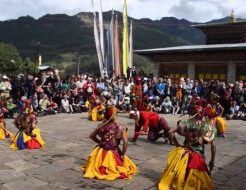
Bhutan Naked Festival 2024
The Jambay Lhakhang, situated in Bumthang and en route to the Kurjie Lhakhang, is the venue for…
Start Date: 15th November 2024
End Date: 18th November 2024
Destination: Jambay Lhakhang, Choekhor, Bumthang
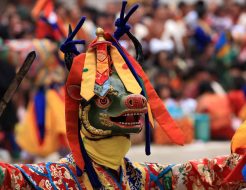
Bhutan Thimphu Festival Tour 2024
One of the biggest festivals in the country is the Thimphu Tshechu. This Thimphu festival tour is…
Start Date: 13th Sept 2024
End Date: 15th Sept 2024
Destination: Tashi Chhodzong, Thimphu
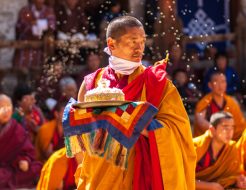
Punakha Festival Tshechu 2024
Punakha, situated in the western part of Bhutan, serves as the winter residence of the Je Khenpo,…
Start Date: 19th - February 2024
End Date: 21st February 2024
Destination: Punakha Dzong
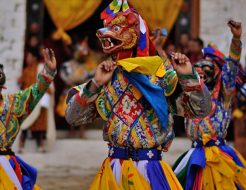
Paro Bhutan Festival 2024
The Paro Festival, an annual event held every spring, stands as one of the most vibrant and…
Start Date: 21st March, 2024
End Date: 25th March, 2024
Destination: Rinpung Dzong, Paro
CONTACT US
- homeThimphu, Bhutan
- emailbookbhutantour@gmail.com
- emailinfo@bhutantouragency.com
- +975-17614054
- +975-02-340662
- +975-17614054
- rdtamang





